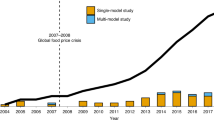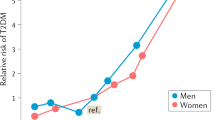Abstract
Objective:
Children with bronchopulmonary dysplasia (BPD) often suffer from growth failure because of disturbances in energy balance with an increase of resting energy expenditure (REE). Evaluation of REE is a useful tool for nutritional management. Indirect calorimetry is an elective method for measuring REE, but it is time consuming and requires rigorous procedure. The objective of this study was to test accuracy of prediction equation to evaluate REE in BPD children.
Patients and methods:
Fifty-two children aged 4–10 years with BPD (30 boys and 22 girls) and 30 healthy lean children (20 boys and 10 girls) were enrolled. In this study, indirect calorimetry was compared to four prediction equations (Schoffield-W, Schoffield-HW, Harris–Benedict and Food and Agriculture Organization equation) using Bland–Altman pair wise comparison.
Results:
The Harris–Benedict equation was the best equation to predict REE in children with BPD, and Schoffield-W was the best in healthy children. For the children with chronic lung disease of prematurity the Harris–Benedict equation showed the lowest mean predicted REE−REE measured by indirect calorimetry difference (difference=15 kcal/day; limits of agreement −266 and 236 kcal/day; 95% confidence interval for the bias −207 to 177 kcal/day), and graphically, the best agreement. For the group of healthy children, it was the Schofield-W equation (−2.9 kcal/day; limits of agreement −275 and 269 kcal/day; 95% confidence interval for the bias −171 to 165 kcal/day), and graphically, the best agreement.
Conclusion:
Differences in prediction equation are minimal compared to calorimetry. Prediction equation could be useful in the management of children with BPD.
This is a preview of subscription content, access via your institution
Access options
Subscribe to this journal
Receive 12 print issues and online access
$259.00 per year
only $21.58 per issue
Buy this article
- Purchase on Springer Link
- Instant access to full article PDF
Prices may be subject to local taxes which are calculated during checkout


Similar content being viewed by others
References
Abrams SA (2001). Chronic pulmonary insufficiency in children and its effect on growth and development. J Nutr 131, S938–S941.
Ashley MA, Broomhead L, Alle JR, Gaskin KJ (2001). Variations in the measurement of resting energy expenditure in children with cystic fibrosis. Eur J Clin Nutr 55, 896–901.
Atkinson S (2001). Special nutrition needs of infants for prevention of and recovery from bronchopulmonary dysplasia. J Nutr 131, S942–S946.
Bancalari E, Nelson C, Sosenko I (2003). Bronchopulmonary dysplasia: changes in pathogenesis, epidemiology and definition. Semin Neonatol 8, 63–71.
Bandini L, Morelli JA, Must A, Dietz WH (1995). Accuracy of standardized equations for predicting metabolic rate in premenarcheal girls. Am J Clin Nutr 62, 711–714.
Béghin L, Budniok T, Vaksmann G, Boussard-Delbecque L, Michaud L, Turck D et al. (2000). Simplification of the method of assessing daily and nightly energy expenditure in children, using heart rate monitoring calibrated against open circuit indirect calorimetry. Clin Nutr 19, 425–435.
Behnke AR, Wilmore JH (1974). Assessment of skinfold thicknesses. In: Englewood C (ed). Evaluation and Regulation of Body Build and composition. Englewood Chiffs: NJ, Prentice Hall, New-York. pp 1–175.
Bland JM, Altman DG (1986). Statistical methods for assessing agreement between two methods of clinical measurement. Lancet 1, 307–310.
Brook GCD (1975). Determination of body composition of children from skinfold measurements. Arch Dis Child 46, 182–184.
De Meer K, Westerterp KR, Houwen RH, Berger R (1997). Total energy expenditure in infants with bronchopulmonary dysplasia is associated with respiratory status. Eur J Pediatr 156, 299–304.
Dumas C, Skaff C, Just J, Tounian P, Fontaine J, Grimfeld A et al. (1997). Body composition of children with chronic lung disease. Pediatr Pulm 16, S174–S176.
Farrell PA, Fiascone JM (1997). Bronchopulmonary dysplasia in the 1990s: a review for the paediatrician. Curr Probl Pediatr 27, 133–163.
Filippone M, Sartor M, Zacchello F, Baraldi E (2003). Flow limitation in infants with bronchopulmonary dysplasia and respiratory function at school age. Lancet 361, 753–754.
Firouzbakhsh S, Mathis RK, Dorchester WL, Oseas RS, Groncy PK, Grant KE et al. (1993). Measured resting energy expenditure in children. J Pediatr Gastroenterol Nutr 16, 136–142.
Fok TF, Gu GJ, To KF, Xu F, Ng PC, Yin J (2001). Oxygen consumption by lungs with acute and chronic injury in a rabbit model. Intens Care Med 27, 1532–1538.
Goran MI, Kaskoun M, Johnson R (1994). Determinants of resting energy expenditure in young children. J Pediatr 125, 362–367.
Gregoire MC, Lefebvre F, Glorieux J (1998). Health and developmental outcomes at 18 months in very preterm infants with bronchopulmonary dysplasia. Pediatrics 101, 856–860.
Harris JA, Benedict FA (1919). Biom Study Basal Metab Man. Carnegie Institute of Washington: Washington, DC.
Hsu A, Heshka S, Janumala I, Song MY, Horlick M, Krasnow N et al. (2003). Larger mass of high-metabolic-rate organs does not explain higher energy expenditure in children. Am J Clin Nutr 77, 1506–1511.
Jobe AH, Bancalari E (2001). Bronchopulmonary dysplasia. Am J Respir Crit Care Med 163, 1723–1729.
Kao LC, Durand DJ, Nickerson BG (1988). Improving pulmonary function does not decrease oxygen consumption in infants with bronchopulmonary dysplasia. J Pediatr 112, 616–621.
Kaplan AS, Zemel BS, Neiswender KM, Stallings VA (1995). Resting energy expenditure in clinical pediatrics: Measured versus prediction equations. J Pediatr 127, 200–205.
Kistorp C, Toubro S, Astrup A, Svendsen OL (2000). Measurements of body composition by dual-energy X-ray absorptiometry improve prediction of energy expenditure. Ann NY Acad Sci 904, 79–84.
Kurzner SI, Garg M, Bautista DB, Bader D, Merrit RJ, Warburton D et al. (1988). Growth failure in infants with bronchopulmonary dysplasia: nutrition and elevated resting metabolic expenditure. Pediatrics 81, 379–384.
Maffeis C, Schutz Y, Micciolo R, Zoccante L, Pinelli L (1993). Resting metabolic rate in six-to-ten-year-old obese and nonobese children. J Pediatr 122, 556–562.
Molnar D, Jeges S, Erhardt E, Shutz Y (1995). Measured and predicted resting metabolic rate in obese and non obese adolescents. J Pediatr 127, 571–577.
Molnar D, Schutz Y (1998). Fat oxidation in non obese and obese adolescents: effect of body composition and pubertal development. J Pediatr 132, 98–104.
Rodriguez G, Moreno LA, Sarria A, Fleta J, Bueno M (2000). Resting energy expenditure in children and adolescents: agreement between calorimetry and prediction equations. Clin Nutr 21, 255–260.
Schofield WN (1985). Predicting basal metabolic rate, new standards and review of previous work. Hum Clin Nutr 39, 5–42.
Schols A, Fredrix E, Soeters P, Westerterp KR, Wouters EF (1991). Resting energy expenditure in patients with chronic obstructive pulmonary disease. Am J Clin Nutr 54, 983–987.
Schulze K, Stefanski M, Masterson J, Spinnazola R, Ramikrishnan, Dell RB et al. (1986). An analysis of the variability in estimates of bioenergetic variables in preterm infants. Pediatr Res 20, 422–427.
Schutz Y, Deurenberg P (1996). Energy metabolism: overview of recent methods used in human studies. Ann Nutr Metab 40, 183–193.
Sempé M, Pedron G, Roy-Pernot MP (1979). Auxologie: méthodes séquences. Theraplix: Paris.
Sentongo TA, Tershakovec AM, Mascarenhas MR, Mascarenhas MR, Watson MH, Stallings VA (2000). Resting energy expenditure and prediction equations in young children with failure to thrive. J Pediatr 136, 345–350.
Weir JB (1949). New methods for calculating metabolic rate with special reference to protein metabolism. J Physiol 109, 1–9.
World Health organization. Energy protein requirements (1985) Report of a joint FAO/WHO/UNU expert consultation, Technical Report Series, WHO: Geneva 724.
Author information
Authors and Affiliations
Corresponding author
Additional information
Guarantor: F Gottrand.
Contributors: LB conceived the analysis and the manuscript; FG directed the project; LB performed the statistic; CM participated in the planning.
Rights and permissions
About this article
Cite this article
Bott, L., Béghin, L., Marichez, C. et al. Comparison of resting energy expenditure in bronchopulmonary dysplasia to predicted equation. Eur J Clin Nutr 60, 1323–1329 (2006). https://doi.org/10.1038/sj.ejcn.1602463
Received:
Revised:
Accepted:
Published:
Issue Date:
DOI: https://doi.org/10.1038/sj.ejcn.1602463
Keywords
This article is cited by
-
A review and guide to nutritional care of the infant with established bronchopulmonary dysplasia
Journal of Perinatology (2023)
-
Energy expenditure and body composition in infants with bronchopulmonary dysplasia at term age
European Journal of Pediatrics (2022)



